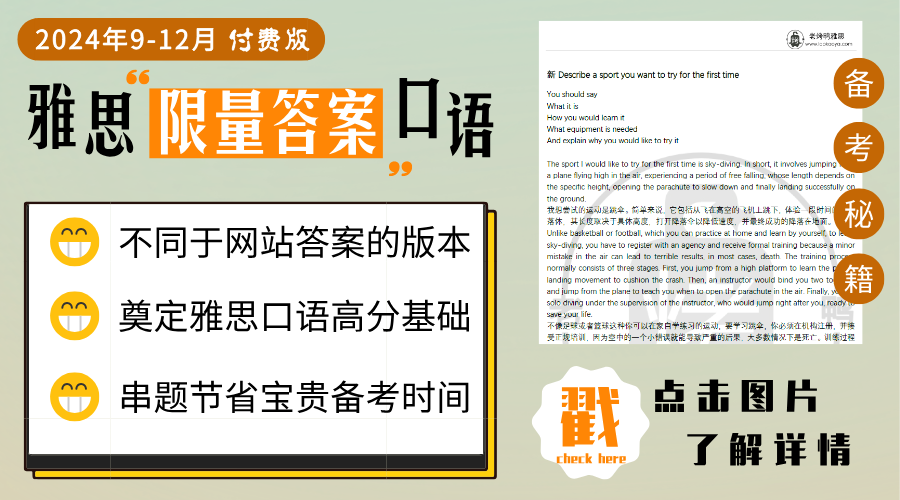剑桥雅思16Test3Passage1阅读答案解析 Roman shipbuilding and naviga […]

剑桥雅思16Test3Passage1阅读答案解析 Roman shipbuilding and navigation 罗马造船与航海
剑桥雅思16阅读第三套题目第一篇文章的13道题由5道TRUE/FALSE/NOT GIVEN判断和8道总结型填空题组成。难度非常低,基本上可以算是剑桥雅思上最简单的一篇文章了。希望大家都能全对。下面是具体每道题目的答案解析。
点击查看这篇雅思阅读对应的原文翻译与其中出现的高频词汇:
雅思阅读真题词汇 剑桥雅思 16 Test 3 Passage 1 罗马造船技术与航海
剑桥雅思16Test3Passage1阅读原文翻译 Roman shipbuilding and navigation 罗马造船与航海
剑桥雅思16 Test3 Passage1阅读答案解析老烤鸭雅思原创解析,请勿抄袭转载
第1题答案:FALSE
对应原文:第1段:The Romans were not traditionally sailors but mostly land-based people, who learned to build ships from the people that they conquered, namely the Greeks and the Egyptians.
答案解析:原文指出,罗马人的造船技艺是从希腊人和埃及人那里学来的。而非题干描述的传授给希腊人和埃及人,因此判断答案为FALSE。
第2题答案:NOT GIVEN
对应原文:第2段:they were fixed using a method called mortise and tenon, whereby one plank locked into another without the need for stitching.
答案解析:原文中确实提到使用mortise and tenon来固定木板,但并没有说这需不需要skilled craftsmen。因此判断答案为NOT GIVEN。同学们在做题的时候切不可过度推理,觉得既然榫卯是门技术,那肯定就需要相应的skilled craftsmen,一切以原文给的信息为准。
第3题答案:FALSE
对应原文:第2段:Mediterranean shipbuilders shifted to another shipbuilding method, still in use today, this article is from Laokaoya webiste. which consisted of building the frame first and then proceeding with the hull and the other components of the ship.
答案解析:从第2段可以看出,后来的造船方法是先建框架,然后是船体和船只的其他部分。题干描述的还是之前的造船方法,因此判断为FALSE。
第4题答案:TRUE
对应原文:第3段:Rome’s navy became the largest and most powerful in the Mediterranean, and the Romans had control over what they therefore called Mare Nostrum meaning ‘our sea’.
答案解析:这道题只是将原文中的control替换为dominated,然后打乱句子顺序而已,很容易判断为TRUE。
第5题答案:TRUE
对应原文:第4段:rowers were not slaves but mostly Roman citizens enrolled in the military.
答案解析:第4段最后提到,“大多数划桨者不是奴隶,而是加入军队的罗马公民”。题干只是将enrolled in改成了from,其他都是原词,由此判断答案为TRUE。
第6题答案:lightweight
对应原文:第3段:Warships were built to be lightweight and very speedy.
答案解析:根据warship以及speedy和quickly的对应定位到第3段,由并列关系确定lightweight为答案。
第7题答案:bronze
对应原文:第3段:They had a bronze battering ram
答案解析:从题干可以推断空上填的应该是某种材料,由此锁定bronze。
第8题答案:levels
对应原文:第4段:The ‘trireme’ was the dominant warship from the 7th to 4th century BCE. It had rowers in the top, middle and lower levels
答案解析:根据trireme定位到第4段的这句话,空前词three对应top,middle和lower,由修饰关系确定答案为levels。
第9题答案:hull
对应原文:第5段:They had a wider hull, double planking and a solid interior for added stability. Unlike warships, their V-shaped hull was deep underwater
答案解析:这道题有两种做法,一种是根据broad与wider的同义替换,锁定hull,另一种是根据后面lay far below the surface of the sea与deep underwater的对应,同样可以锁定hull。
第10题答案:triangular
对应原文:第5段:They had from one to three masts with large square sails and a small triangular sail at the bow.
答案解析:从题干可以看出,空上要填船帆的形状,由此锁定triangular。
第11题答案:music
对应原文:第5段: In order to assist them, music would be played on an instrument, and oars would then keep time with this.
答案解析:这道题因为没有明确的定位词,要稍微难那么一点点。不过,通过on merchant ships and warships我们可以推测出,接下来要填的是战舰和商船的共同点,由此锁定第5段的最后。played与used对应,根据修饰关系确定答案为music。
第12题答案:grain
对应原文:第6段:agricultural products (e.g. grain from Egypt’s Nile valley)
答案解析:基本属于送分题。根据agricultural products定位到第六段,由such和e.g.的对应确定答案为grain。
第13题答案:towboats
对应原文:第6段:Large merchant ships would approach the destination port and, just like today, be intercepted by a number of towboats that would drag them to the quay.
答案解析:顺着two main ports在原文中的对应往下看,根据pulled与drag的同义替换定位到这句话,由主被动变换确定towboats为正确答案。
剑桥雅思16Test3Passage2阅读答案解析 Climate change reveals ancient artefacts in Norway’s glaciers
剑桥雅思16Test3Passage3阅读答案解析 Plant thermometer triggers springtime growth by measuring night time heat
